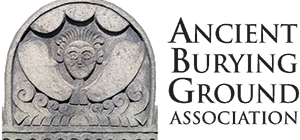The earliest stones in the Ancient Burying Ground featured only words about the deceased, with no decorative carving. But even these “plain style” stones cost enough to be considered status symbols.
Richard Edwards, 1718
“Here Lies Interd yE Body of Mr. Richard Edwards Who Dyed April 20th 1718 Aetatis Sue 71“
Richard Edwards was Queen’s attorney for the Colony of Connecticut, yet his gravestone bears nothing but a simple epitaph. Spellings that seem wrong to modern eyes, such as “Interd” and “Dyed,” can be found on gravestones into the early 1800s, reflecting the lack of standardized spelling or dictionaries throughout the period. The erratic spacing that divided a name like “Edwards” onto two lines can be found on gravestones throughout the 1700s, seemingly reflecting poor planning on the part of the carver.
Sometimes size alone was enough to make a statement. Tablestones – large rectangular slabs of stone supported by stone legs – typically featured only words. But just the considerable cost of simply transporting such a massive piece of stone from quarries in towns like Portland along the Connecticut River bespoke the importance of those whose graves they mark.
The Makers of the Markers Brochure (below) identifies some of the carvers whose work can be seen at the Ancient Burying Ground.
